Published
on 28
Jul 2023
|
All rights reserved.
|
|
|
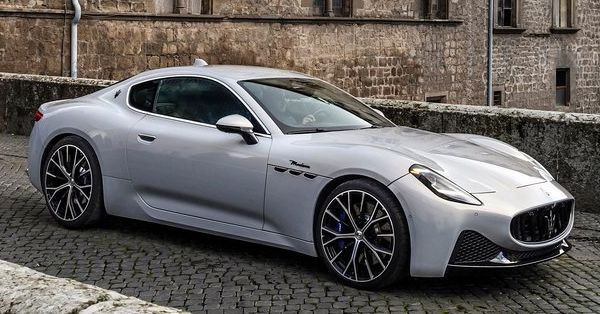 |
|
GranTurismo
is the most competitive Maserati to date, the jewel of the crown.
|
|
Ask yourself, which model
best represents the image of Maserati, I guess most will say
GranTurismo and its open-top version GranCabrio. Maserati built many
fine GTs, of course, such as the original Ghibli and 3500GT, but its
modern GT offering – after the image-damaging DeTomaso era – started
from the 3200GT of 1998. It evolved into 4200GT and reinforced the
image as a charismatic, luxurious and relatively reliable Maserati 2+2.
However, it was the Pininfarina-designed GranTurismo that took the
Maserati GT concept to a new height: incredibly sexy looks, an angry if
slightly underpowered V8, well-balanced chassis, spacious interior and
decent build quality made it a solid choice in the competitive luxury
GT segment. It served Maserati for 12 long years and finally came to
retirement in 2019 with 40,520 cars built. Not exactly a volume seller,
but pretty successful by the standard of Maserati.
I like the fact that Maserati doesn't change for the sake of change.
The outgoing GranTurismo was the most beautiful GT built in our time.
Even at the very end of its lifecycle it still looked fresh and
head-turning on the road, easily besting the efforts by Aston Martin,
Bentley, BMW, Mercedes and even the highly acclaimed Ferrari Roma.
Because it is still the sexiest car around, there is really no reason
to alter its perfect shape. Maserati needs just to tweak a few details,
such as headlights, front intakes and air splitter accompanied with
larger wheels (20-inch front and 21-inch rear), to keep it up to date.
Dimensions are mostly unchanged, too, except widening the body by 110
mm, which improves its proportion further and provides more space
inside. The result is again the sexiest GT in the world.
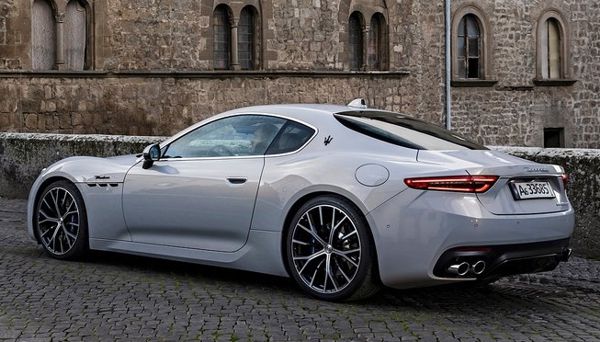 |
|
The
first rule of car design: if you have a design this sexy, don't change
it, just tweak the details.
|
|
However, under the familiar skin, everything is new. While the old car
was built around a conventional steel monocoque construction, the new
one is made of mixed materials, 65% of which is aluminium, while the
rest consists of high-strength steel and magnesium, so to optimize
strength and weight. This is why it is able to lose weight: with petrol
engine, it tips the DIN scale at 1720 kg, a massive 160 kg lighter than
the old car. Even the last MC Stradale was 50 kg heavier than it.
Besides, it is more aerodynamic efficient. Petrol models has its drag
coefficient lowered from 0.32 to 0.28, while electric version achieves
a remarkable 0.26.
Suspension continues to be double-wishbone up front, but the rear axle
turns to multi-link setup. Air springs are added to all corners, which
allow the car to adjust its ride height according to speed, too.
Adaptive dampers are standard. The larger wheels are wrapped with
265/30ZR20 tires up front and 295/30ZR21 rubbers at the rear, 20mm and
10mm respectively wider than before.
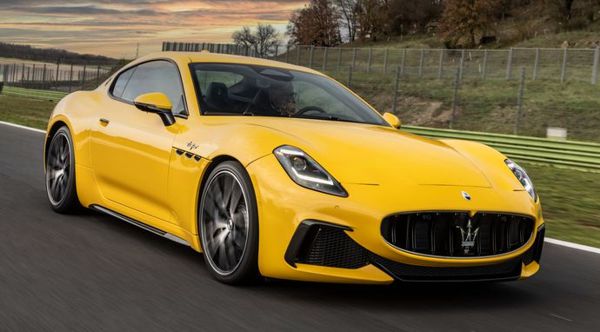
|
|
It
gets wider, it gets faster, it gets 4WD, yet it gets lighter than ever.
|
|
Both petrol models,
namely Modena for standard and Trofeo for faster model, are powered by
Maserati's Nettuno V6. Displacing 3.0 liters, charged by twin-turbo and
served with the unique "pre-chamber" combustion technology, the
90-degree V6 produces 490 hp and 442 lbft on Modena, or 550 hp and 479
lbft on Trofeo, both released at 6500 rpm and 3000 rpm respectively. It
is not quite as high in state of tune as the version powering MC20
supercar, and loses dry-sump lubrication as well, understandably, but
is already far more than the 460 hp and 383 lbft produced by the old
car's 4.7-liter naturally aspirated V8. Moreover, it is mated to ZF
8-speed automatic (instead of the old 6-speeder) and a standard 4WD
system, making the kerb weight reduction even more remarkable.
The short V6 not only sits gracefully under the sloping clamshell
bonnet, but allows the front differential to be positioned ahead of the
engine instead of below it, improving center of gravity and keeping the
bonnet low. 70 percent of power normally goes to the rear axle to keep
rear-drive handling characteristics, and more will flow forward when
traction is lost. The Trofeo gets an active rear LSD while Modena uses
a mechanical one.
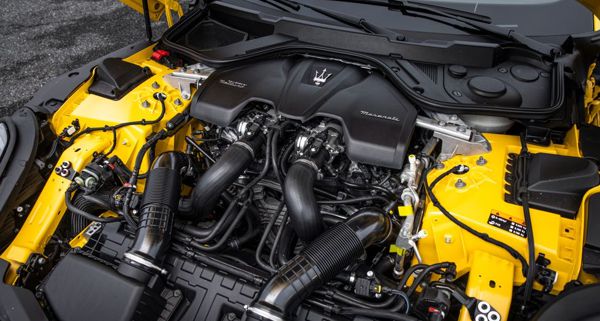
|
|
Nettuno
V6 is powerful, flexible and eager to rev, but its soundtrack is no
match with the outgoing V8.
|
|
Combining more power, less weight and 4-wheel traction, the new
GranTurismo is a lot faster, of course. Modena model sprints from rest
to 60 mph in 3.8 seconds, 124 mph in 13.0 seconds and flat out at 188
mph, about the same as a Mercedes-AMG SL55. Trofeo raises the bar to
0-60 in 3.4 seconds, 0-124 in 11.4 seconds and tops 199 mph, marginally
quicker than an SL63. That puts it in the ballpark of Ferrari Roma,
Porsche 911 GTS, Bentley Continental GT and Aston Martin DB12, too. By
the way, the old car managed just 185 mph and 0-60 in 4.6 ticks.
Spec-wise, the only area the new GranTurismo fails to match its
predecessor is static balance. Thanks in part to the front differential
and driveshafts, its front-to-rear weight distribution is worsened from
49:51 to 52:48. Ferrari Roma and Aston DB12 have better balance than it.
One thing nothing else come close to the GranTurismo is cabin space.
Thanks to the 2929mm wheelbase, it remains the only 2-door GT on the
market that offers genuine 4 seat accommodation. It can take 4
average-size adults for a short trip as long as they are under 6 feet
tall and the driver is willing to compromise a bit on legroom. The
310-liter boot behind is also large enough for their weekend luggage.
This make the Maserati far more usable than other luxury GTs.
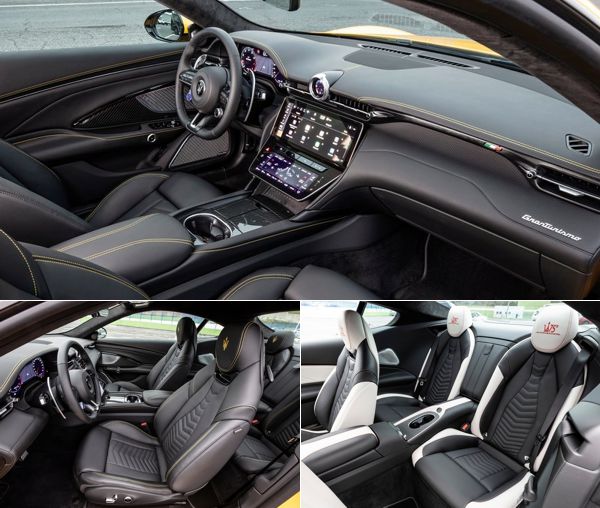 |
|
No
one else in the 2-door luxury GT camp can provide geniune 4-seat
accommodation like it.
|
|
Except a few cheap switches, the cabin is finished with materials and
build quality matching its price. The center console is occupied by a
pair of touchscreen, the upper one is for infotainment and the lower
one for climate control. The user interface is not the easiest to use,
blame to small icons and complicated menus, but otherwise it feels
modern and responsive. There is over-the-air update capability and a
“Hey Maserati” voice control, in addition to head-up display. Above the
center console is a modern take on Maserati’s traditional clock, which
is now a
round display that is switchable to other functions, such as g-force
meter, compass or smartphone read-out. Driving position is near
perfect, as the seat is mounted low enough and offer a great balance
between comfort and support. Thanks to slimmer A-pillars and relatively
large windows, outward visibility is excellent.
The Nettuno V6 bursts into life and idles with a bit diesel vibration
and gruff. Throttle response low down is not quite as keen as the
naturally aspirated V8, of course, while the exhaust note sounds hollow
and muffled beside the old V8’s spine-tingling soundtrack. However, the
Nettuno has its own character. Its power delivery is impressively
flexible and lag-free, more so than the one on MC20 because it employs
smaller turbos. Power builds up quickly and the 479 lbft of peak torque
is released from 3000 rpm, pushing the car strongly while the ZF auto
slices through its ratios cleanly. As a result, the Trofeo feels
massively quick from the mid-range. Its V6 keeps spinning all the way
to its 7200 rpm redline with an enthusiasm only the best Italian motors
are known for, all the while playing a bassy and increasingly loud
soundtrack. Each downshift in corner is accompanied with a feast of
pops and crackles.
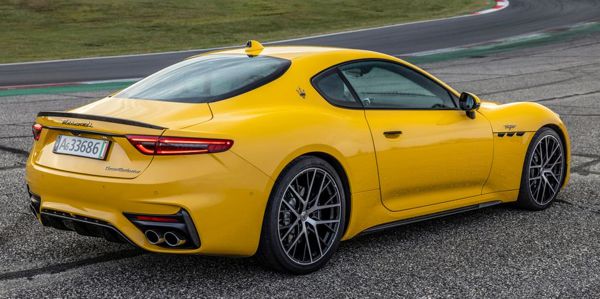
|
|
Plusher
and more usable than Porsche or Ferrari, better to drive than most
other rivals. Plus, out-beauty them all.
|
|
On the other hand, when cruising on highway at 100 mph the engine
registers only 2300 rpm at top gear, and the noise slips behind the
background. Depending on your mood, the new GranTurismo can be an
exciting fast car as well as a refined cruiser.
The well-mannered powertrain is well matched by the chassis. The
GranTurismo displays supple ride on most of its suspension modes. Only
sharper and higher frequency bumps will unsettle it, as this is a
common problem for air-sprung cars. Meanwhile, body control and
traction are beyond criticism. The steering is quick and precise, if
not very feelsome. Chassis balance is spot-on, as understeer is well
suppressed and you can induce oversteer with throttle. Braking is
powerful, although the pedal lacks intial bite. Overall speaking, the
Maserati is not as sporty as
911 or Ferrari Roma, of course, but it feels sharper and more agile
than Bentley Continental GT, Mercedes-AMG SL, BMW M8
and the outgoing Aston DB11. Coupling to peerless usability and beauty,
it is Maserati’s most competitive product to date, the jewel of the
crown.
Between the £140,000 Modena and £160,000 Trofeo, the
cheaper car might be the better choice. Its performance loss is not
obvious in the real world, while some may argue that its steering even
sweeter, since the mechanical LSD works more naturally than the
electronic one.
|
Verdict:      |
Published
on 28
Jul 2023
|
All rights reserved.
|
|
GranTurismo Folgore
|
|
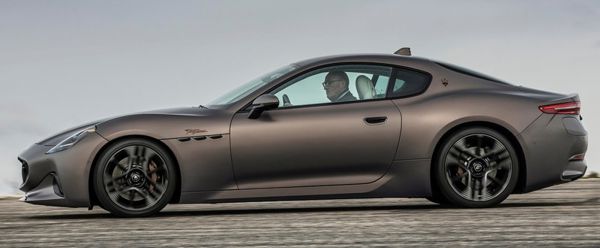 |
|
200
mph top speed and 2.6 seconds 0-60 mph makes it the fastest Maserati of
all.
|
|
As fast as Trofeo is, it
is not the range-topping model in the GranTurismo line-up. That title
goes to the electric version, Folgore, which means lightning in
Italian. The Folgore is priced at around £190,000, compared with
the £160,000 Trofeo and £140,000 Modena. It is also the
fastest, and not by a small margin, as we shall see.
Maserati is brave to build its first full-electric car based on the
petrol-powered GranTurismo. BMW employs the same strategy for its i4 /
4-Series, i5 / 5-Series and i7 / 7-Series, but their CLAR platform is
designed to accommodate underfloor battery, so that these cars look
ungainly tall. To Maserati, preserving the beautiful low-slung
proportion is key to the success of its GT, so it rejected the idea of
skateboard platform and opted for putting the battery in the spine of
the car, like what Mercedes
SLS AMG Electric Drive experimented a
decade ago.
The Folgore’s lithium-ion battery is placed in T-shape layout, within
the transmission tunnel and under the rear seat. The battery cells are
supplied by LG Chem while battery pack is assembled in Maserati’s
Mirafiori factory near Turin. Capacity is 92.5 kWh gross or 83 kWh net,
giving the Folgore a WLTP driving range of 450 km (280 miles), a bit
shorter than Porsche Taycan Turbo S.
Unusually, the Maserati EV employs not 2 but 3 electric motors, 2 of
them mounted at the rear axle and drive the rear wheels individually
(there is no mechanical connection between them) so that torque
vectoring is easily achievable. Another drives the front axle through
an open differential to provide extra pull and all-wheel traction.
These permanent magnet motors are all identical, each good for 402
horsepower and 332 pound-foot of torque. They also have their own
silicone-carbide inverters.
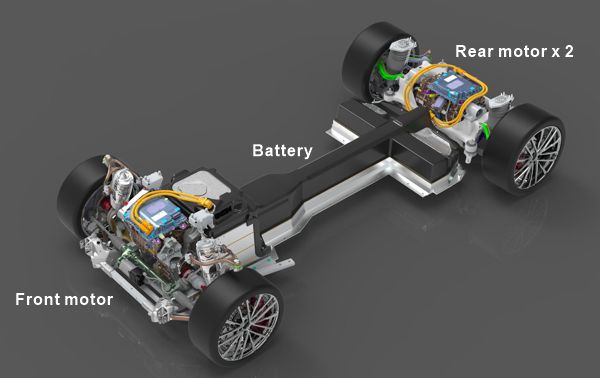
|
|
Maserati
is wise to avoid skateboard platform so that it can retain the
GranTurismo's beautiful proportion.
|
|
Theoretically, the Folgore is good for 1200 horsepower, but the battery
is the bottleneck, which limits the output to 761 horsepower and 996
lbft of torque. (Maserati said future upgrades to the battery will
unlock full power, stay tuned!) Still, that is a lot more powerful than
the V6 models. Even though the Folgore is a massive 465 kg heavier than
its petrol siblings, it is easily the quickest. 0-60 mph is done in a
staggering 2.6 seconds, a reduction of 0.8 from the Trofeo, while 0-124
mph is shortened by 2.6 seconds to merely 8.8, which is a full second
quicker than Porsche Taycan Turbo S. Moreover, while Porsche needs a
2-step gearbox to achieve its 162 mph top speed, the Maserati takes a
single gear to reach 202 mph, thanks to motors that spin to 17,500 rpm.
Running on state of the art 800V electrical architecture, the Maserati
EV is capable of DC charging up to 270 kW. Doing so, it takes 18
minutes to charge from 20 to 80 percent, or 5 minutes for adding 100 km
range.
Inevitably, placing the battery in the spine rather than floor means
its center of gravity is not as low as some other EVs, although part of
that disadvantage is offset by the car’s lower waistline and roofline.
It might roll more in corner as a result, but concentrating mass to the
roll axis means the body roll is more progressive and easier to
correct. Besides, the Folgore achieves 50:50 weight distribution, 2
percent better on either side than V6 models.
That’s the changes found underneath its skin. Outside, surprisingly,
the Folgore is nearly identical to the petrol models – the only thing
to distinguish it is the lack of tailpipes and the cap of charging port
just under the left taillight. Open the trunk, you will find 40 liters
of luggage space has been sacrificed to the battery. Cabin space,
however, is unchanged, ditto all the trims and equipment bar the
software interface.
Despite carrying so much more weight, modifications made to the chassis
are remarkably few. It rides on the same wheel and tire sizes (although
EV-dedicated energy saving tires are standard fitted here), the same
brakes with 380mm and 350mm discs (although assisted with regenerative
braking) and the same air-sprung suspension (though with unique
calibration). The battery contributes to chassis rigidity, so no
additional reinforcement is considered necessary.
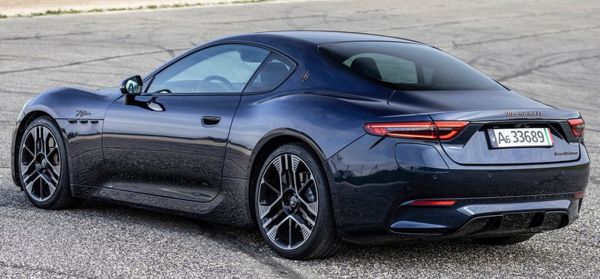 |
|
Compared
with its V6 siblings, it feels more relaxing but less sporty. A great
GT, if not an emotional choice.
|
|
Press the start button, the car surprises you with a V8 rumble playing
through audio speakers. Move on, strangely, the synthesized sound fades
out and falls behind the background. There are 4 drive modes, from Max
Range mode that saves energy and maximizes regenerative braking to GT
mode (power is limited to 80%), Sport mode (100%) and Corsa mode
(sharpens throttle response and allows oversteer). Engage the last 2
modes, floor down the throttle and you will be pressed against the
backrest. However, while the scenery falls back quickly, it happens
incredibly smooth and quiet, more so than a Tesla Plaid or Taycan Turbo
S. The Maserati feels effortless and relaxing at any speeds. The air
suspension soaks up bumps and rolling comfort is superb. Noise is well
isolated. More so than its petrol siblings, the Folgore is an
outstanding grand tourer.
Some might say its good manner lacks character. Yes, a bit more emotion
at hotter modes could make it more memorable, especially when this is
an Italian car. However, doing so could also reveal its shortcomings.
Compared with its V6 siblings, it feels more relaxing but less sporty.
Its extra 465 kg of mass inevitably dampens its braking and turn-in
response. While the Trofeo responds to steering and throttle more
immediately, the Folgore majors on good balance and fluent handling,
not sudden change of direction or overly eager throttle. In tighter
corners, its mass is more easily felt through gentle understeer.
Still, it feels lighter and more agile than a Taycan, which is arguably
its closest rival despite additional doors. It is also smoother and
more relaxing to travel long distances. In short, the Folgore is a
great GT, if not an emotional choice.
|
Verdict:     |
|